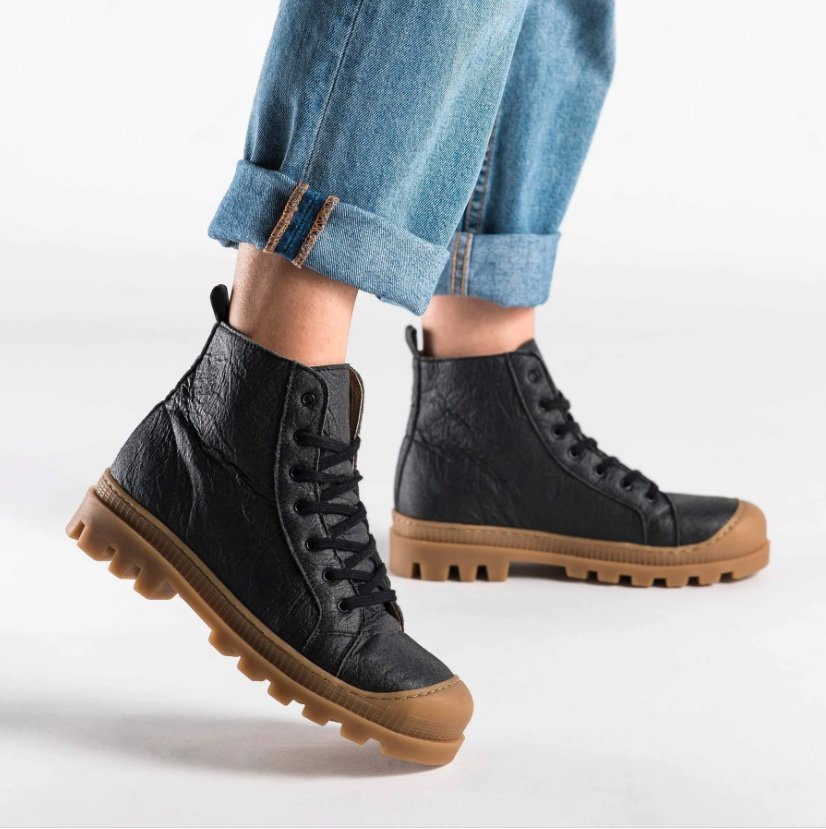What is More Sustainable: Leather or Vegan Leather?
By Jaclyn Tracy
Photo by Jan de Keijzer
In recent years, there has been an increasing demand for vegan leather as an alternative to traditional animal-based leather. Vegan leather is most often a synthetic material made from a variety of sources such as polyurethane, microfiber, and recycled plastic. While there are some pros and cons to both vegan and real leather, many people are turning to vegan leather as a more ethical and sustainable option.
Pros of Vegan Leather:
Ethical: One of the biggest advantages of vegan leather is that it does not require the use of animals. No animal is killed or harmed in the production of vegan leather, which is a major factor in the growing popularity of this material. Many people who are vegan or have ethical concerns about the treatment of animals opt for vegan leather as a more humane alternative.
Sustainability: The production of animal-based leather is often associated with a range of environmental issues such as deforestation, water pollution, and high carbon emissions. In contrast, vegan leather is often made from recycled or (sometimes) sustainable materials, making it a more environmentally friendly option.
Variety: Vegan leather can be produced in a range of colors, textures, and finishes, making it a versatile material for fashion and design. This allows for a wider range of options when it comes to creating clothing, shoes, and accessories.
Cons of Vegan Leather:
Durability: One potential downside of vegan leather is that it may not be as durable as real leather. While advancements in synthetic materials have made vegan leather more durable than ever, it may not last as long as genuine leather. This means that items made from vegan leather may need to be replaced more often, which can be less sustainable in the long run.
Chemicals: The production of vegan leather often requires the use of chemicals such as polyurethane, which can be harmful to the environment and human health if not disposed of properly. Some people also have concerns about the potential health risks associated with wearing clothing or accessories made from synthetic materials.
Price: Vegan leather can often be more expensive than real leather, as the production process may be more complex and require specialized machinery. This can make it a less accessible option for some consumers.
Comfort & Appearance: Leather is a natural material that can conform to the shape of the wearer's body, providing a comfortable and personalized fit. Real leather has a unique texture and appearance that many people find attractive. It is often associated with luxury and high-quality craftsmanship.
Biodegradable: In terms of end-of-life disposal, real leather is biodegradable, while vegan leather made from synthetic materials is not. However, some brands are developing plant-based vegan leather, such as pineapple leather or mushroom leather, which are biodegradable and compostable — these are the best vegan leather alternatives in our opinion.
While vegan leather can be a more ethical and sustainable option, it may not be as durable as real leather. Ultimately, the choice between vegan and real leather comes down to personal preference and priorities—and really depends on the different types of vegan leather you choose.
Some marketers use the term "vegan leather" as a form of greenwashing. Greenwashing is a marketing tactic that involves making false or misleading claims about the environmental benefits of a product or service in order to appeal to environmentally conscious consumers.
READ MORE
WHAT IS GREENWASHING & HOW DO YOU AVOID IT?
While vegan leather is generally considered to be a more sustainable and ethical alternative to traditional leather, not all vegan leathers are created equal. Some vegan leathers may be made from synthetic materials that are not biodegradable or may require a significant amount of energy to produce. Additionally, some companies may use the term "vegan leather" even if their product is not entirely animal-free, which can be misleading to consumers.
Therefore, it is important for consumers to research the specific materials and production processes used to create any product marketed as "vegan leather" to determine whether it is truly a sustainable and ethical choice.
Is Vegan Leather Just Plastic?
Most vegan faux leather is made out of plastic, but new types of vegan leather are emerging every year. And from our assessment, choosing a plant-based vegan leather is your best bet, environmentally.
The Different Types of Vegan Leather
The sustainability of leather and vegan leather (also known as faux leather or synthetic leather) depends on various factors, including the production process, the materials used, and the end-of-life disposal. Some of the most common types include:
Photo by Ananas-Anam
POLYURETHANE (PU) LEATHER
This type of vegan leather is made by coating a fabric or paper base with a polyurethane layer. PU leather is a versatile material that can be made to look and feel like real leather, and it is often used in the fashion industry for shoes, handbags, and clothing. This type of vegan leather takes an extremely long time to break down, and can actually be even more harmful to the environment than traditional leathers.
POLYVINYL CHLORIDE (PVC) LEATHER
PVC leather is another synthetic material that is often used as a substitute for real leather. It is made by coating a fabric or paper base with a layer of PVC. However, PVC is not as environmentally friendly as other types of vegan leather due to the toxic chemicals used in its production.
PIÑATEX
Piñatex is a natural leather alternative made from pineapple leaf fibers. It is a sustainable and eco-friendly material that is biodegradable and compostable. This innovative material manufactured by Ananas Anam, featured in Vogue, is taking the fashion world by storm. This is one of the most sustainable types of vegan leather.
Noah Piñatex Black high-top vegan sneaker boots available in off white and black Breathable and Water Resistant sneaker boots.
MUSHROOM LEATHER OR MUSKIN
Mushroom leather is a relatively new type of vegan leather that is made from mycelium, the root structure of mushrooms. It is a sustainable and biodegradable material that has a texture similar to real leather.
This organic textile, dubbed MuSkin, comes from a type of fungus. The fungi can be grown to the specific size and shape required for designs. Waterproofing is necessary but can be done without harmful chemicals, making this a biodegradable alternative to leather. Softer than suede and antibacterial, this is one clever innovation to look out for in the near future. — GoodOnYou
Making fashion history, Stella McCartney launched the Frayme Mylo™️ is the world's first-ever luxury bag crafted from mycelium – the root-like structures of fungi.
CORK LEATHER
Cork leather is made from the bark of cork oak trees. It is a sustainable and environmentally friendly material that is lightweight, water-resistant, and durable.
RECYCLE MATERIALS
Additionally, vegan leather can be made from recycled materials, such as plastic bottles, which can help reduce waste. If you’re after hardy leather accessories, without the animal cruelty, recycled rubber could be a great choice because it’s durable and easy to care for.
The Venturi Hexamesh Gravel Natural Grey The B-Mesh used by Veja is made from recycled plastic bottles. 3 plastic bottles are used to create a pair of sneakers. This upcycling process creates a smart fabric, both breathing and water-repellent.
The Most Sustainable Version of Vegan Leather
The most sustainable version of vegan leather is generally considered to be natural materials such as Piñatex and mushroom leather, which are biodegradable and compostable. These materials have a lower environmental impact than synthetic materials like PU and PVC leather, which are often made from non-renewable resources and can release toxic chemicals during production. Cork leather is also a sustainable option that is both lightweight and durable.
Overall, both real leather and vegan leather have their environmental impacts, and the sustainability of either option depends on how responsibly it is produced and how it is disposed of at the end of its useful life. If you are concerned about sustainability, it is essential to research the brands and materials used to make the products you are considering and choose those that have a lower environmental impact.
ABOUT THE AUTHOR
Jaclyn Tracy is the founder of SISTAIN. Her goal is to make a greater difference by educating, activating and making sustainable consumerism not only easier, but aspirational. She believes success is in the collective impact, getting a whole group of people to change their behavior by committing to choosing sustainable brands, less waste and imperfect progress.













